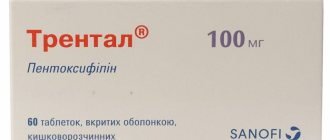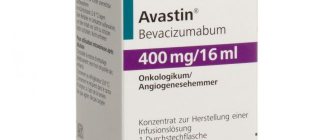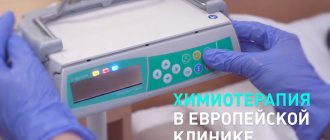Pharmacological properties of the drug 5-fluorouracil
Pharmacodynamics. Fluorouracil (5-fluorouracil) is an antitumor agent from the group of antimetabolites. As an antagonist, pyrimidine disrupts DNA synthesis and thus inhibits cell division. Fluorouracil itself does not have antineoplastic activity; its antitumor effect is manifested in the body after the enzymatic transformation of fluorouracil into phosphorylated forms - 5-fluorouridine and 5-fluorodeoxyuridine. Pharmacokinetics. There is significant interindividual and individual variability in the absorption of fluorouracil from the gastrointestinal tract after oral administration. Fluorouracil is also metabolized during first pass through the liver. The bioavailability of fluorouracil is 0–80%. Only intravenous and intravenous administration of fluorouracil is possible. After intravenous administration, fluorouracil is distributed throughout the body, especially in rapidly proliferating tissues such as bone marrow, gastrointestinal mucosa and neoplasms. Fluorouracil penetrates the BBB and the placental barrier. The volume of distribution of fluorouracil is 0.12 l/kg body weight, binding to plasma proteins is approximately 10%. The metabolism of fluorouracil occurs in the liver and is similar to the metabolism of uracil. There is a rapid enzymatic transformation of fluorouracil into the active metabolite dihydro-5-fluorouracil, the half-life of which is significantly longer than the half-life of fluorouracil. Metabolization also produces non-toxic compounds - carbon dioxide and urea. The average half-life of fluorouracil from blood plasma is 10–20 minutes and depends on the dose. 3 hours after intravenous administration, unchanged fluorouracil is not detected in the blood plasma. Fluorouracil is excreted primarily through the lungs in the form of carbon dioxide (60–80%). Fluorouracil is also excreted via the kidneys as unchanged parent compound (7–20%), approximately 90% within the first hour. The renal clearance of fluorouracil is approximately 170–180 ml/min. In patients with impaired renal function, fluorouracil is eliminated more slowly.
Use of the drug 5-fluorouracil
The dose and regimen of therapy are determined individually depending on the patient’s condition and type of cancer, and also depending on whether 5-Fluorouracil “Ebewe” is used as monotherapy or in combination with other types of treatment. It is necessary to begin treatment with 5-Fluorouracil “Ebeve” in a hospital setting. The total daily dose for adults should not exceed 1 g. Typically, the dose for adults is determined based on 1 kg of the patient's actual body weight, but for patients with significant obesity, edema, ascites and other forms of abnormal fluid retention in the body, the dose is determined based on 1 kg ideal body weight. 5-Fluorouracil "Ebewe" is administered by intravenous injection, intravenous infusion or intravenous infusion. Below are indicative recommendations regarding the dosage of the drug.
Treatment of colorectal cancer During the initial course of therapy, the drug can be administered by infusion or injection. Administration by infusion is preferable because there are fewer toxic effects with this route of administration.
IV infusion. A daily dose of 15 mg/kg body weight (600 mg/m2 body surface), but not more than 1 g per infusion, is diluted with 300–500 ml of 5% glucose solution or 0.9% sodium chloride solution. The solution for infusion is administered intravenously over 4 hours. In the following days, the drug is administered in the same dose until toxic effects appear or the total dose reaches 12–15 g. Some patients were administered up to 30 g of fluorouracil, 1 g/day day (maximum daily dose). If side effects from the hematopoietic or gastrointestinal tract occur, the next administration of the drug is postponed until hematological parameters are restored and toxic effects disappear. Alternatively, 5-Fluorouracil "Ebewe" can be administered by continuous 24-hour infusion.
IV injections. 12 mg/kg body weight (480 mg/m2 body surface) is administered by daily intravenous injection for 3 days. If there are no signs of toxic effects, you can continue to administer the drug at a dose of 6 mg/kg body weight (240 mg/m2 body surface) on the 5th, 7th and 9th day of the course. For maintenance therapy, the drug is administered at a dose of 5–10 mg/kg body weight (200–400 mg/m2 body surface) once a week. If side effects occur, the next administration of the drug is postponed until the toxic effects disappear.
Treatment of breast cancer For the treatment of breast cancer, 5-Fluorouracil "Ebeve" is used in combination with other chemotherapy drugs, for example methotrexate and cyclophosphamide or doxorubicin and cyclophosphamide. With such treatment regimens, 5-Fluorouracil “Ebeve” is administered intravenously at 10–15 mg/kg body weight (400–600 mg/m2 body surface) on the 1st and 8th day of a course lasting 28 days. 5-Fluorouracil "Ebewe" can also be administered by continuous 24-hour IV infusion, with the usual dose being 8.25 mg/kg body weight (350 mg/m2 body surface area).
Other methods of administering IV infusion. A daily dose of 5–7.5 mg/kg body weight (200–300 mg/m2 body surface) is administered by continuous 24-hour intravenous infusion. In some cases, regional intravenous infusions may be used to treat primary tumors or metastases.
Special Patient Populations Dose reduction is recommended in the case of cachexia, major surgery in the previous 30 days, impaired bone marrow function, and in the presence of impaired liver or kidney function. There is no need for dose adjustment when treating elderly patients.
Instructions for personnel The solution must be taken from the bottle/ampoule immediately before use. If a precipitate has formed in the preparation as a result of cooling, it is dissolved by heating to 60 °C and vigorous shaking. Before use, the drug is cooled to body temperature. As when working with other cytotoxic drugs, when manipulating 5-Fluorouracil "Ebewe" it is necessary to follow safety rules: use protective clothing (gown, cap, mask, goggles and disposable gloves), if possible, work in a room specially designated for these purposes. It is necessary to avoid contact of fluorouracil solutions with the skin and mucous membranes. If this happens, they are washed thoroughly with soap and water. If fluorouracil solution gets into your eyes, rinse them with plenty of water. Pregnant women are not allowed to work with the drug.
5-fluorouracil
Description of the active substance (INN):
Fluorouracil
Dosage form:
solution for intravascular and intracavitary administration
Pharmachologic effect:
An antitumor agent from the group of antimetabolites. It is an antimetabolite of uracil, competes with it for thymidylate synthetase, blocks DNA synthesis, causes the formation of structurally imperfect RNA (by introducing it into its synthesis), inhibiting the division of tumor cells. A few hours after administration, the concentration in tumor tissue is higher than in healthy tissue.
Indications:
Colon and rectal cancer, breast cancer, esophageal cancer, stomach cancer, pancreatic cancer, primary liver cancer, ovarian cancer, cervical cancer, bladder cancer, malignant tumors of the head and neck, prostate cancer, adrenal cancer, vulvar cancer, penile cancer , carcinoid, skin cancer (for ointment).
Contraindications:
Hypersensitivity, suppression of bone marrow hematopoiesis (leukocyte count less than 5 thousand/μl, platelets less than 100 thousand/μl), pregnancy, lactation. With caution. Renal and/or liver failure, acute infectious diseases of a viral, fungal or bacterial nature (including tuberculosis, chickenpox, herpes zoster), infiltration of the bone marrow by tumor cells, previous intensive radiation or chemotherapy, cachexia.
Side effects:
From the digestive system: loss of appetite, nausea, vomiting, heartburn, taste disturbance, esophagitis, inflammation and ulceration of the gastrointestinal mucosa, ulcerative stomatitis, diarrhea, bleeding from the gastrointestinal tract, impaired liver function. From the cardiovascular system: myocardial ischemia (angina pectoris, LV failure, shortness of breath), which can be observed within several hours after administration; usually develops after second or subsequent administrations; myocardial infarction, thrombophlebitis at the injection site. From the central nervous system: acute cerebellar syndrome (ataxia, nystagmus), headache, disorientation, confusion, euphoria. From the hematopoietic organs: leukopenia (usually 9-14 days after each course; the lowest level of leukocytes is observed after 9-14, less often - 20 days; recovers after about 30 days), neutropenia, anemia, thrombocytopenia. From the senses: optic neuritis, lacrimation, stenosis of the lacrimal canaliculi, blurred vision, photophobia, cataracts, cortical blindness (at high doses). Allergic reactions: skin rash, dermatitis, urticaria, photosensitivity, bronchospasm, anaphylactic shock. From the skin: hyperpigmentation of the skin, dryness and cracks of the skin, palmar-plantar erythrodysesthesia syndrome (tingling sensation in the hands and feet followed by pain, hyperemia and swelling), alopecia, telangiectasia, changes in nails (including destruction). Other: azoospermia, amenorrhea, hyperuricemia, pneumopathy (cough, shortness of breath), epistaxis (nosebleeds), weakness (usually occurs immediately after administration and persists for 12-36 hours), development of secondary infections.
Directions for use and dosage:
Fluoruacil is included in many chemotherapy treatment regimens, and therefore, when choosing the route of administration, regimen and doses in each individual case, one should be guided by data from special literature. Administered intravenously by stream or drip, intracavity (it is recommended to use an appropriate infusion pump to ensure a constant infusion rate), intracavity. IV drip, according to any of the following schemes (administration is stopped when side effects occur - stomatitis, diarrhea, leukopenia or thrombocytopenia; resumed after the number of leukocytes increases to 3-4 thousand / μl and platelets to 80-100 thousand / μl) : 1) 1 g/sq.m/day intravenous drip continuously for 96-120 hours; 2) 600 mg/sq.m IV on days 1 and 8 of the course in combination with other drugs. When used in combination with calcium folinate, fluorouracil doses are usually reduced by 25-30%; 3) 500 mg/sq.m or 12-13.5 mg/kg daily for 3-5 days, the interval between courses is 4 weeks; 4) 600 mg/sq.m or 15 mg/kg (highest single dose 1 g) once a week for 6-10 weeks. When used in combination with calcium folinate, the dose of fluorouracil is usually reduced by 25-30%. In obese patients or patients with increased body weight due to edema, ascites or other causes of fluid retention, it is recommended to estimate body weight without taking them into account (“dry” weight).
Special instructions:
If stomatitis or diarrhea occurs, treatment with the drug must be stopped until these symptoms disappear. With the development of palmoplantar erythrodysesthesia syndrome, oral pyridoxine can be prescribed at a dose of 100-150 mg/day. During the treatment period, it is necessary to monitor the total number of leukocytes and platelets, determine hematocrit and Hb, the activity of AST, ALT, LDH, bilirubin, and examine the patient’s oral cavity to identify ulcers (before each administration of the drug). Patients who develop leukopenia should be closely monitored for signs of infection.
Interaction:
The effectiveness and/or toxicity is increased by other antitumor drugs (interferon alfa2a, cyclophosphamide, vincristine, methotrexate, cisplatin, adriamycin), calcium folinate. Radiation therapy—additive bone marrow suppression. With long-term combined use with mitomycin C, the appearance of hemolytic uremic syndrome was observed. When taken concomitantly with sorivudine, severe leukopenia was observed, in some cases leading to death. Fluorouracil should not be used after or in combination with aminophenazone, phenylbutazone and sulfonamide therapy. Chlordiazeopoxide, disulfiram, griseofulvin and isoniazid may enhance the activity of fluorouracil. Due to the suppression of natural protective mechanisms during treatment with fluorouracil, it is possible to intensify the process of replication of the vaccine virus or reduce the production of antibodies in response to the vaccine when vaccinated with live or inactivated vaccines, therefore the interval between the end of the drug and vaccination with live or inactivated vaccines is from 3 to 12 months .
Contraindications to the use of the drug 5-fluorouracil
Hypersensitivity to fluorouracil; suppression of bone marrow function, especially after radiation therapy or treatment with other anticancer drugs; significant deviations in the amount of formed elements in the blood; bleeding; stomatitis, ulcers of the oral mucosa and gastrointestinal tract; severe diarrhea; severe dysfunction of the liver and/or kidneys; severe infectious diseases; severe cachexia; the level of bilirubin in the blood plasma is 85 µmol/l. During treatment with fluorouracil, active vaccination should be avoided.
Side effects of the drug 5-fluorouracil
Infections and infestations Uncommon (0.1% but ≤1%) - fever.
From the blood and lymphatic system Very common (10%) - leukopenia and thrombocytopenia. The preventive measures described below must be followed. Frequent (1%, but ≤10%) - agranulocytosis, anemia, suppression of bone marrow function.
From the immune system: Uncommon (0.1%, but ≤1%) - allergic reactions.
Metabolic disorders Single (≤0.01%). The risk of severe and prolonged adverse reactions soon after starting treatment with fluorouracil is greatest in patients with low levels of dihydropyrimidine dehydrogenase (DPD) activity (for any reason, in particular due to the use of DPD inhibitors such as eniluracil or the antiviral drug sorividin). It is recommended to monitor DPD activity at the beginning of treatment.
Nervous system disorders Common (1%, but ≤10%). A transient, reversible cerebral syndrome may occur, in which ataxia, confusion, and extrapyramidal motor and cortical disturbances are observed. Usually these phenomena disappear after discontinuation of the drug. Uncommon (0.1% but ≤1%) - drowsiness. Single (≤0.01%). Cases of leukoencephalopathy, reversible with immediate discontinuation of fluorouracil, have been reported. The risk of developing leukoencephalopathy is higher in patients with BPH deficiency. To diagnose leukoencephalopathy, it is advisable to use the method of diffusion-weighted magnetic resonance imaging. With combination chemotherapy (in particular, fluorouracil combined with mitomycin C or cisplatin), cases of ischemic stroke have been reported.
Ophthalmological disorders Rare (0.01%, but ≤0.1%) - conjunctivitis, excessive lacrimation, dacryostenosis, visual impairment, photophobia, optic neuritis.
Cardiac: Uncommon (0.1% but ≤1%) - chest pain, ischemia, ECG changes, left ventricular dysfunction. Rare (0.01%, but ≤0.1%) - myocardial infarction. Single cases (≤0.01%) - cardiogenic shock.
Vascular disorders Uncommon (0.1%, but ≤1%) - nosebleeds, arterial hypotension, thrombophlebitis.
From the gastrointestinal tract Very common (10%) - inflammation of the mucous membranes (in particular stomatitis, esophagitis, pharyngitis, proctitis). Frequent (1%, but ≤10%) - diarrhea, nausea, vomiting, anorexia. Uncommon (0.1%, but ≤1%) - gastrointestinal ulcers, gastrointestinal bleeding. Single (≤0.01%) - damage to liver cells, liver necrosis with a fatal outcome.
Skin and subcutaneous tissue disorders Common (1%, but ≤10%) - reversible alopecia. Uncommon (0.1%, but ≤1%) - dermatitis, skin changes (in particular dry skin, cracks, erosions, erythema, rash, itching, photosensitivity, allergic skin reactions, pigmentation, hyperpigmentation or depigmentation in the form of stripes near veins , nail changes, nail loss). A rare complication with bolus administration of high doses of the drug and with prolonged continuous infusions is palmoplantar erythrodysesthesia syndrome.
Musculoskeletal and connective tissue disorders Uncommon (0.1%, but ≤1%) - necrosis of the nasal bones.
From the kidneys and urinary tract : Uncommon (0.1%, but ≤1%) - renal failure.
From the reproductive system : Uncommon (0.1%, but ≤1%) - impaired spermatogenesis and ovulation.
General effects and local reactions Uncommon (0.1%, but ≤1%) - increased fatigue.
Changes in laboratory parameters Single (≤0.01%). There have been isolated cases of increased prothrombin time with the combined use of fluorouracil and warfarin.
Fluorouracil
The incidence of side effects listed below was determined according to the following gradation: very often (≥10%); often (≥1%, <10%); uncommon (≥ 0.1%, <1%); rare (≥ 0.01%, <0.1%): very rare (<0.01%).
Allergic reactions: uncommon - skin rash, dermatitis, urticaria, bronchospasm; rarely - anaphylactic shock.
From the hematopoietic organs: very often - leukopenia, neutropenia, myelosuppression, mainly dose-limiting; rarely - thrombocytopenia, anemia. The most significant decrease in the number of leukocytes is usually observed from 9 to 14 days (up to 25 days), platelets - from 7 to 17 days of treatment. Very rarely - pancytopenia, agranulocytosis.
From the immune system: often - immunosuppression with an increase in the incidence of infectious diseases; rarely - generalized allergic reactions.
From the digestive system: very rarely - anorexia, nausea, vomiting, inflammation and/or ulceration of the mucous membranes of the gastrointestinal tract (including stomatitis, pharyngitis, esophagitis, proctitis); often - diarrhea, heartburn, change in taste; uncommon - dehydration, bleeding from the gastrointestinal tract, liver dysfunction, cholecystitis, mucositis; very rarely - liver cell damage, fatal liver necrosis.
From the cardiovascular system: very often - ischemic changes on the ECG, dilated cardiomyopathy; rarely - pain in the heart, arrhythmias, decreased blood pressure, myocarditis; very rarely - myocardial infarction, angina pectoris, heart failure, cardiomyopathy, cardiogenic shock, peripheral cerebral circulation disorder, Raynaud's syndrome, cardiac arrest, sudden death.
From the nervous system: often - transient reversible cerebral syndrome (ataxia, confusion, extrapyramidal motor and cortical disorders), drowsiness, sensory disturbances, euphoria, nystagmus, retrobulbar neuritis, headache, disorientation, asthenia; infrequently - vertigo; very rarely - leukoencephalopathy with symptoms such as ataxia, speech impairment, disorientation, myasthenia gravis, aphasia, convulsions, coma (after using fluorouracil in high doses or in patients with dihydropyrimidine dehydrogenase deficiency), cerebral infarction (with combination therapy with mitomycin or cisplatin ).
Endocrine disorders: frequency unknown - increased blood concentrations of total thyroxine (T4) and total triiodothyronine (T3), without increased levels of free thyroid-stimulating hormone (TSH) and without clinical signs of hyperthyroidism.
From the senses: rarely - blepharitis, conjunctivitis, irritation of the mucous membrane of the eyes, excessive lacrimation due to stenosis of the tear ducts, photophobia, cataracts, cortical blindness (at high doses), diplopia, visual impairment, optic neuritis, limited eye mobility, eversion of the eyelid .
From the reproductive system: infrequently - reversible inhibition of the function of the gonads, leading to amenorrhea or azoospermia.
From the skin and skin appendages: often - alopecia (reversible); uncommon - hyperpigmentation of the skin, depigmentation in the form of stripes near the veins, dryness and cracks of the skin, erythema and itching of the skin, telangiectasia, photosensitivity; rarely - changes in the nails (onycholysis, pain and thickening of the nail bed, paronychia), palmoplantar erythrodysesthesia syndrome (tingling sensation in the hands and feet followed by pain, hyperemia, swelling and peeling), convergence of the nail plates (rarely).
Other: infrequently - weakness, thrombophlebitis at the injection site, thromboembolism; rarely - fever, nosebleeds, cough, shortness of breath, hyperuricemia, development of secondary infections, sepsis.
Special instructions for the use of the drug 5-fluorouracil
The effects of monotherapy with fluorouracil during pregnancy have not been sufficiently studied. When treated with fluorouracil in combination with other cytotoxic drugs and radiation therapy, both cases of birth of children with developmental defects and cases of birth of healthy children were noted, despite the use of fluorouracil in the first trimester of pregnancy. Studies in various animal species have shown that fluorouracil is teratogenic and fetotoxic, and also adversely affects fertility. 5-Fluorouracil "Ebewe" is not recommended for use during pregnancy, especially in the first trimester. In each individual case, it is necessary to carefully weigh the expected benefit to the mother and the potential risk to the fetus. It is not known whether fluorouracil is excreted in breast milk. During treatment with fluorouracil, breastfeeding should be stopped. Recommendations for the use of fluorouracil in children have not been developed. Treatment with 5-Fluorouracil "Ebewe" should be carried out under the supervision of a qualified oncologist with experience in the use of antimetabolites. It is necessary to start treatment with fluorouracil in a hospital setting. With adequate treatment with fluorouracil, leukopenia usually develops. The maximum decrease in the number of leukocytes is usually observed between the 7th and 14th day of the first course of therapy, but sometimes the maximum decrease can be observed after 20 days of treatment. The white blood cell count usually normalizes by day 30. It is recommended to monitor platelet and leukocyte counts daily and discontinue treatment if the platelet count decreases to ≤100×109/L and the leukocyte count to ≤3×109/L. If the leukocyte count decreases to ≤2×109/L, especially in the presence of granulocytopenia, it is recommended to hospitalize patients in a hospital isolation ward and take measures to prevent the development of systemic infections. Treatment should also be stopped at the first signs of stomatitis or oral ulcers, severe diarrhea, gastrointestinal ulcers, gastrointestinal bleeding, as well as bleeding and hemorrhage of any location. Fluorouracil has a low therapeutic index - the difference between its therapeutic and toxic dose is small. It is unlikely that the therapeutic effect of a drug can be achieved without some toxicity, so careful selection of patients and dosing of the drug is necessary. Fluorouracil should be prescribed with caution to patients with impaired renal or liver function (including jaundice). Caution is also necessary when treating patients who have experienced chest pain during previous courses of therapy, as well as patients with a history of cardiac disease. In case of severe cardiotoxic effects, treatment with fluorouracil should be discontinued. Particular caution is required when treating high-risk patients (who have received high doses of radiation therapy to the pelvis, alkylating drugs, and those who have undergone adrenalectomy or hypophysectomy). During treatment with fluorouracil and for 3 months after the end of therapy, patients (both men and women) should use effective contraception. Depending on individual sensitivity, 5-Fluorouracil "Ebewe" may affect the ability to drive vehicles and operate machinery.
5-Fluorouracil-Ebeve, 50 mg/ml, concentrate for solution for infusion, 20 ml, 1 pc.
Treatment with 5-fluorouracil-Ebeve should be carried out under the supervision of an oncologist experienced in the use of antimetabolites. Taking into account the risk of developing severe toxic reactions, incl. and with a fatal outcome, the doctor is obliged to inform the patient in detail about the possible risk and the necessary safety measures. Treatment must begin in a hospital setting.
Before using the 5-fluorouracil-Ebeve solution, if a precipitate forms under the influence of low temperatures, the solution should be heated to 60 ° C, shaking vigorously, and then cooled to room temperature. If the sediment has not dissolved, the drug must be disposed of in accordance with current regulations for the disposal of hazardous waste.
With adequately selected therapy with 5-fluorouracil, leukopenia usually develops. A minimum white blood cell count is usually observed between 7 and 14 days of the first course of therapy, but sometimes this minimum can be observed after 20 days, which returns to normal by the 30th day of therapy. During therapy with 5-fluorouracil-Ebeve, it is necessary to perform a clinical blood test at least once a week.
If stomatitis, diarrhea, bleeding from the gastrointestinal tract or any other localization occurs, treatment with the drug must be stopped until these symptoms disappear.
With a significant decrease in body weight, decreased bone marrow function, impaired liver or kidney function, in the early postoperative period (up to 30 days) after major surgery, the initial dose should be reduced by 1/3 or 1/2.
Caution should be exercised when prescribing to patients who have previously been exposed to high doses of radiation to the pelvic area or who have received alkylating drugs.
Since the toxicity of 5-fluorouracil significantly increases when taken concomitantly with inhibitors of the enzyme dihydropyrimidine dehydroginase (brivudine, sorivudine), a break is required before taking the drug 5-fluorouracil-Ebeve to restore the activity of endogenous and fluorinated pyrimidines.
Men and women of childbearing age should use reliable methods of contraception during treatment with 5-fluorouracil Ebeve and for at least 3 months after.
Impact on the ability to drive vehicles and operate machinery.
Due to the potential for side effects such as drowsiness, headache and confusion, caution should be exercised when engaging in potentially hazardous activities that require increased concentration and psychomotor speed.
Drug interactions 5-fluorouracil
The medical literature describes combination therapy with fluorouracil in combination with calcium folinate (folinic acid). With such combination therapy, fluorouracil may cause more severe side effects, in particular severe diarrhea. The effectiveness and toxicity of therapy increases when fluorouracil is used in combination with other cytotoxic drugs (cyclophosphamide, vincristine, methotrexate, cisplatin, doxorubicin), alpha interferon or folinic acid. When combined with other drugs that inhibit bone marrow function, fluorouracil dosage adjustment is necessary. Dose reduction may also be required in the case of concomitant or previous radiation therapy. The cardiotoxicity of anthracyclines may be increased when combined with fluorouracil. Before or during treatment with fluorouracil, aminophenazone, phenylbutazone and sulfonamides should not be taken. With simultaneous administration of allopurinol, the toxicity and effectiveness of fluorouracil therapy may be reduced. Chlordiazepoxide, disulfiram, griseofulvin and isoniazid may increase the effectiveness of fluorouracil therapy. Fluorouracil weakens the body's general defense mechanisms, so the immune response is reduced. The use of live vaccines during treatment with fluorouracil may lead to increased viral replication. The development of hemolytic uremic syndrome has been reported after prolonged treatment with fluorouracil in combination with mitomycin. Cimetidine may increase plasma concentrations of fluorouracil. Metronidazole may increase plasma concentrations of fluorouracil and enhance toxic effects. Levamisole may enhance the hepatotoxicity of fluorouracil. Thiazides may enhance the myelotoxicity of anticancer drugs. Vinorelbine in combination with fluorouracil and folinic acid can cause severe inflammation of the mucous membranes. Gemcitabine may increase the systemic exposure of fluorouracil. 5-Fluorouracil “Ebewe” must be diluted with 0.9% sodium chloride solution or 5% glucose solution. No incompatibility was detected with any of the tested carrier solutions. A mixture of 1000 mg Calciumfolinate "Ebewe" (100 ml Calciumfolinate "Ebewe" 10 mg/ml), 5000 mg 5-Fluorouracil "Ebewe" (100 ml 5-Fluorouracil "Ebewe" 50 mg/ml) and 40 ml 0.9% r Sodium chloride in an infusion pump (for example, the “Easy pump” type) is stable at room temperature for 48 hours. There is no information on the possibility of mixing 5-Fluorouracil “Ebewe” with other drugs. Therefore, 5-Fluorouracil "Ebewe" cannot be mixed with other medications (in particular with calcium folinate from other manufacturers).
5-Fluorouracil Ebeve 50 mg/ml 20 ml 1000 mg No. 1 vial.
Full description
5-Fluorouracil (5-Fluorouracil)
1 ml of solution for intravascular and intracavitary administration contains fluorouracil 50 mg. Pharmacological action Pharmacological action - antitumor, cytostatic. In cancer cells, it is converted into 5-fluoro-2-deoxyuridine-5-monophosphate, which is a competitive inhibitor of thymidine synthetase, which leads to stopping the synthesis of DNA and RNA and suppressing cell division. Indications for the drug 5-Fluorouracil-Ebeve Cancer of the esophagus, stomach, pancreas, liver (hepatocellular), ovary, cervix, breast, bladder and prostate; anal, colorectal carcinoma; liver metastases; malignant tumors of the head and neck (mono- and combination therapy). Contraindications Hypersensitivity; pronounced changes in blood composition, inhibition of bone marrow hematopoiesis, hemorrhages; significant impairment of liver and kidney function; severe infections, incl. viral (shingles, chicken pox); stomatitis, ulcerations of the oral cavity and gastrointestinal tract, pseudomembranous enteritis, pregnancy, breastfeeding. Use during pregnancy and breastfeeding is contraindicated. Breastfeeding should be stopped during treatment. Side effects of the drug 5-Fluorouracil-Ebeve Myelosuppression; anorexia, stomatitis, sore throat, pharyngitis, esophagitis, enteritis, ulceration of the gastrointestinal mucosa (including the oral cavity), bleeding, dyspeptic symptoms; heart pain, ischemia, myocardial infarction; confusion, drowsiness, ataxia, euphoria, blurred vision and other central nervous system disorders; renal and liver failure, dermatitis, dry skin, furunculosis and other disorders of regeneration of skin, nails, hair; allergic reactions (up to anaphylactic shock). Method of administration and dose IV, IV, intracavitary (in the form of a concentrate or after dilution in 0.9% sodium chloride solution or 5% glucose solution). When administered daily (once a day) by intravenous infusion - 600 mg/m2 of body surface until side effects appear or by intravenous injection - first 480 mg/m2 for the first 3 days, then 240 mg/m2 ; with weekly administration (once a week) - at an initial dose of 200 mg/m (24-hour infusion) or 600 mg/m (infusion), at a maintenance dose - 200-400 mg/m once a week. The maximum daily dose is not higher than 1 g. The course of therapy is determined by a specialist (depending on the type of disease and course). The dose is adjusted in patients with myelosuppression, cachexia, after surgery, in combination with radiation therapy and other cytostatics. Precautions If side effects from the gastrointestinal tract, blood, central nervous system or heart occur, treatment should be stopped immediately. Prescribed with caution in cases of severe bone metastasis. The shelf life of the drug 5-Fluorouracil-Ebeve is 2 years. Keep in a place protected from light, at a temperature not exceeding 25 °C.
Overdose of the drug 5-fluorouracil, symptoms and treatment
Symptoms Acute: psychotic reactions, drowsiness, increased effect of sedatives, increased toxic effects of alcohol. If sedation is necessary, diazepam can be prescribed intravenously in low doses (for example, starting from 5 mg) with constant monitoring of the functions of the cardiovascular and respiratory systems. Chronic: suppression of bone marrow function, up to the development of agranulocytosis and critical thrombocytopenia, tendency to bleeding, gastrointestinal ulcer, diarrhea, alopecia.
Treatment A specific antidote for fluorouracil is not known. For prophylactic purposes, it is advisable to carry out transfusions of leukocyte or platelet mass. It is necessary to ensure adequate hydration and diuresis, as well as correct electrolyte imbalances. There is usually no need for hemodialysis. The patient should be under strict medical supervision for the earliest possible detection of hematological and late gastrointestinal complications. Further treatment is symptomatic.
Storage conditions for the drug 5-fluorouracil
In original packaging at a temperature of 15–25 °C. Do not refrigerate or freeze! Solutions for infusion with a concentration of 0.35 mg/ml and 15.0 mg/ml, prepared by diluting 5-Fluorouracil “Ebewe” with 5% glucose solution or 0.9% sodium chloride solution, chemically and physically stable for 28 days if stored in the refrigerator or at room temperature, protected or not protected from light. From a microbiological point of view, the diluted solution should be used immediately. If the solution for infusion is not used immediately, the responsible person monitors the period and conditions of its storage. The solution should not be stored for more than 24 hours at 2–8°C unless it has been prepared under controlled and validated aseptic conditions.
List of pharmacies where you can buy 5-fluorouracil:
- Moscow
- Saint Petersburg




